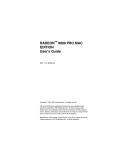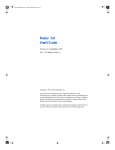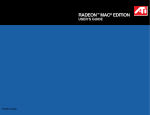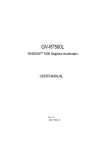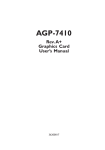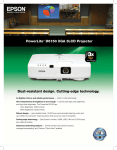Download ATI Technologies 9000 - Radeon Pro User`s guide
Transcript
RADEON™ 9000 PRO MAC EDITION User’s Guide P/N: 137-40360-00 Copyright © 2002, ATI Technologies Inc. All rights reserved. ATI and all ATI product and product feature names are trademarks and/or registered trademarks of ATI Technologies Inc. All other company and/or product names are trademarks and/or registered trademarks of their respective owners. Features, performance and specifications are subject to change without notice. Product may not be exactly as shown in the diagrams. Reproduction of this manual, or parts thereof, in any form, without the express written permission of ATI Technologies Inc. is strictly prohibited. Disclaimer While every precaution has been taken in the preparation of this document, ATI Technologies Inc. assumes no liability with respect to the operation or use of ATI hardware, software or other products and documentation described herein, for any act or omission of ATI concerning such products or this documentation, for any interruption of service, loss or interruption of business, loss of anticipatory profits, or for punitive, incidental or consequential damages in connection with the furnishing, performance, or use of the ATI hardware, software, or other products and documentation provided herein. ATI Technologies Inc. reserves the right to make changes without further notice to a product or system described herein to improve reliability, function or design. With respect to ATI products which this document relates, ATI disclaims all express or implied warranties regarding such products, including but not limited to, the implied warranties of merchantability, fitness for a particular purpose, and non-infringement. ii Table of Contents Introduction. . . . . . . . . . . . . . . . . . . . . . . . . . . . . . . . . . 1 What You'll Need......................................................................................... 2 Related Documentation............................................................................... 3 Multimedia Features. . . . . . . . . . . . . . . . . . . . . . . . . . . 4 Viewing 3D Graphics................................................................................... 5 ATI Displays Control Panel........................................................................ 7 3D Memory Monitor ................................................................................... 9 Using the 3D Memory Monitor.............................................................. 9 Display.................................................................................................. 10 Textures ................................................................................................ 10 Buffers .................................................................................................. 10 DVD............................................................................................................. 10 ATI Displays Preferences.......................................................................... 11 ATI HELP .................................................................................................. 11 Using QuickTime Playback ...................................................................... 12 Using Digital Flat Panel (DVI-I)............................................................... 13 Video Mode Table...................................................................................... 15 Supported 2D Modes............................................................................ 15 Digital Flat Panel.................................................................................. 16 Specifications.............................................................................................. 17 System Requirements ........................................................................... 17 Operating System ................................................................................. 17 Glossary . . . . . . . . . . . . . . . . . . . . . . . . . . . . . . . . . . . 19 Index . . . . . . . . . . . . . . . . . . . . . . . . . . . . . . . . . . . . . . 22 iii Introduction The RADEON 9000 PRO MAC EDITION represents the next generation in 3D and video acceleration for your Power Macintosh computer. It includes 64MB of DDR memory for fast 32-bit true color 3D graphics. Flexible dual-display support for multiple combinations of CRT and Digital Flat Panel monitors. Your new graphics accelerator provides: • Flexible dual-display support enabling many combinations utilizing the ADC (Apple Display Connector), VGA (using a third party adapter), and DVI-I connectors. • OpenGL® and QuickDraw 3D accelerator providing superior 3D rendering performance and advanced imaging and filtering techniques. • QuickTime playback accelerator for full screen, full motion, TV quality video. 1 What You'll Need The RADEON 9000 PRO MAC EDITION runs with the following minimum system requirements: NOTE NOTE NOTE • Any Power Macintosh computer with an AGP expansion slot. • Mac OS 9.2.1 or higher or Mac OS X version 10.1.3 or higher. • OpenGL 1.2.2 (required for some 3D graphics). • Apple multi-frequency monitor, VGA-style monitor (see note below), DVI-I style digital flat panel or Apple ADC style digital flat panel. • QuickTime 5.0 (earlier versions are NOT supported) or higher. • Minimum 64MB of system memory required for Mac OS 9.2.1. • Minimum 128MB of system memory required for Mac OS X version 10.x. OpenGL 1.2.2 or higher is required to obtain full 3D graphics functionality in Mac OS 9.2.1 applications. OpenGL 1.2.2 is only available from Apple as part of Mac OS 9.2.1. or 9.2.2. VGA monitors require a DVI-I-to-VGA adapter (included) to connect to the RADEON 9000 PRO MAC EDITION graphics accelerator. Future references to Mac OS 9 and Mac OS X in this manual are intended to be generic and inclusive of their respective versions of the Macintosh operating systems. 2 Related Documentation The README file summarizes the latest product revisions. Click the README icon on the installation disk to open this file. Help is available in both Mac OS X and OS 9 by simply clicking on the button in the ATI Displays control panel or through the Apple Help Center. You can browse through the Help or search for a specific topic. 3 Multimedia Features Your RADEON 9000 PRO MAC EDITION turns your Mac computer into a 3D and 2D graphics powerhouse. You can use your new graphics accelerator card to do the following: • Enjoy true-color 32-bit 2D or 3D graphics up to 2048x1536. • Watch full screen, full motion, TV-quality video using QuickTime playback acceleration. • Output your Mac’s display to digital flat panels. The following information describes these new features in more detail and suggests ways you can optimize your machine to get the most out of your new card. 4 Viewing 3D Graphics RADEON 9000 PRO MAC EDITION’s 3D Acceleration features supports the following advanced 3D graphics capabilities: • OpenGL Support. • QuickDraw 3D RAVE Support. • Twin Cache Architecture. • Single Pass Multi-texturing. • Triangle Setup Engine. • Bilinear/Trilinear Filtering. • Line Anti-aliasing. • Specular Highlights. • Perspectively Correct Texture Mapping. • Mip-Mapping. • Z-buffering and Double-buffering. • Spherical, Dual-Paraboloid, 3D Texturing and Cubic environment mapping. In addition, the RADEON 9000 PRO MAC EDITION brings new and exciting graphics technologies to the Macintosh platform: SMOOTHVISION™ is an anti-aliasing solution that raises the bar for image quality using programmable multi-sampling methods to post-process graphics before they are displayed. SMARTSHADER™ (supported in Mac OS X only) is a new technology which revolutionizes the graphics pipeline by making both the geometry processing and pixel processing stages more programmable than ever before. Developers can easily create amazing new graphics effects while maintaining a high level of performance. 5 HYPER Z™ II makes Z-buffer bandwidth usage more efficient by decreasing the amount of information sent to the frame buffer. CHARISMA ENGINE™ II is a transform and lighting technology which controls changing shapes and lighting while maintaining fast 3D game performance. PIXEL TAPESTRY™ II uses six independent texture units per rendering pipeline giving highly realistic and detailed 3D graphics. VIDEO IMMERSION™ II incorporates MPEG-2 decoding, adaptive de-interlacing, and frame rate conversion. RADEON 9000 PRO MAC EDITION only displays 3D graphics in thousands and millions of colors. When you use 256 colors, there are too few colors to display complex 3D textures, so 3D acceleration is not supported. You can use the 3D Memory Monitor in the ATI Displays control panel, in Mac OS 9 only, to see how memory on your RADEON 9000 PRO MAC EDITION is allocated when displaying 3D graphics. This allows you to optimize 3D performance. 6 ATI Displays Control Panel The ATI Displays control panel provides access to the advanced features that RADEON 9000 PRO MAC EDITION has to offer. To open the ATI Displays control panel using Mac OS X: 1 Click the Hard Disk icon. 2 Click Applications folder. 3 Click Utilities folder. 4 Click ATI Utilities folder. 5 Double-click ATI Displays. For detailed instructions on how to set up and use these features, please refer to ATI Help, which can be accessed through the ATI Displays control panel. To open the ATI Displays control panel using Mac OS 9: 1 Click Apple Menu. 2 Click Control Panels. 3 Click ATI Displays. or 1 Click ATI Config Menu in the menu bar. 2 Click ATI Displays. ATI Displays for Mac OS 9 7 The Display Info dialog presents the current settings of your monitor. The Profile dialog presents information on the specific RADEON graphics card and video driver installed in your computer. Even if the ATI Displays cannot identify your ATI product it will still provide display configuration, driver version and other related information. A warning dialog will display if no ATI product is installed in your computer. The Support dialog provides an internet link to the ATI Technologies’ website. 8 3D Memory Monitor The 3D Memory Monitor, available in Mac OS 9 only, shows how available memory in the accelerator card is allocated when displaying 3D graphics. Using the 3D Memory Monitor When you open 3D graphics on your Mac OS computer, run the 3D Memory Monitor to see how your RADEON 9000 PRO MAC EDITION has allocated 3D memory. To open the 3D Memory Monitor 1 Choose Control Panels from the Apple Menu, or choose ATI Displays from the ATI Config Menu and skip to step 3. 2 Select ATI Displays. 3 Click 3D Memory icon. The 3D Memory Monitor shows you how the video memory on your RADEON 9000 PRO MAC EDITION is allocated between display, textures, and buffers. 9 Display The Screen bar indicates the amount of graphics memory is allocated to the display’s resolution and color depth. The Desktop Pattern bar indicates the amount of memory used by your desktop pattern. To reduce the memory allocated to Display memory: • change the color depth from millions to thousands. • decrease your screen resolution. Textures The Texture bar indicates the number and size of texture maps loaded by 3D applications to add realism to 3D models and environments. The Bitmap bar indicates the memory allocated to non-3D elements like 2D graphics. To reduce the memory allocated to Texture memory, reduce the amount of textures in your 3D graphics. Buffers The Back Buffer bar and the Z-buffer bar are directly related to the size of the 3D window. To reduce the memory allocated to Buffer memory: • reduce the size of the display window containing 3D graphics. • reduce the number of the display windows containing 3D graphics. DVD Adaptive de-interlacing smooths moving images captured from an interlaced source and may improve the quality of DVD movies. 10 ATI Displays Preferences From the ATI Displays drop down menu in Mac OS X only, you can set the Preferences for the ATI Displays control panel. Here you can configure how the ATI Displays control panel starts and exits. ATI HELP ATI HELP is an additional source of information when you are using the ATI Displays control panel. To access the ATI HELP, click on the icon on the ATI Displays control panel. Select a topic from the main ATI HELP window to get detailed instructions for a specific task. 11 Using QuickTime Playback The RADEON 9000 PRO MAC EDITION’s QuickTime playback acceleration allows you to stretch even the smallest movies to full screen size without compromising frame rate or image quality. RADEON 9000 PRO MAC EDITION’s hardware scaler maintains the original quality of your QuickTime movie when scaling to a larger size – even full screen. When the monitor is set to display in grayscale (Mac OS 9 only), QuickTime movies are not accelerated, nor are they converted to color. When playing movies in thousands or millions of colors, the ATI card utilizes the 3D engine’s capabilities to scale and accelerate playback. When scaling video, the RADEON 9000 PRO MAC EDITION uses special hardware techniques (bilinear filtering) to enhance the video quality instead of just repeating pixels. NOTE To use RADEON 9000 PRO MAC EDITION’s playback acceleration, you must have QuickTime version 5.0 or higher installed on your computer. 12 Using Digital Flat Panel (DVI-I) RADEON 9000 PRO MAC EDITION’s DVI-I support feature allows you to output your computer’s display to your DVI-I digital flat panel, providing you with: • Crisper, clearer images. • A true flat screen. • Virtually no eye strain from prolonged viewing. Using RADEON 9000 PRO MAC EDITION DVI-I Connector Your RADEON 9000 PRO MAC EDITION includes support for DVI-I. You can use this feature to connect your RADEON 9000 PRO MAC EDITION to a digital flat panel display. To output your computer’s display to a DVI-I digital flat panel: 1 Ensure your RADEON 9000 PRO MAC EDITION is installed correctly. 2 Looking at the back of your Mac, locate your RADEON 9000 PRO MAC EDITION. 3 Attach one end of your DVI-I cable to the DVI-I connector on your RADEON 9000 PRO MAC EDITION and the other end to the DVI-I connector on your DVI-I flat panel. 13 DVI-I Connector DVI-I monitor port ADC monitor port 4 NOTE ADC Connector Turn on your DVI-I flat panel and your Mac. The DVI-I connector is hot swappable. You no longer need to shut down your computer before attaching a digital flat panel. 14 Specifications Video Mode Table The video mode table below lists the color depth capabilities for the supported resolutions on your RADEON 9000 PRO MAC EDITION. Please consult your monitor’s specifications to determine which resolutions are available with your display. Supported 2D Modes Display Resolution Maximum Refresh Hz 640 x 480 720 x 480 800 x 600 832 x 624 1024 x 768 1152 x 864 1152 x 870 1280 x 960 1280 x 1024 1600 x 900 1600 x 1024 1600 x 1200 1792 x 1344 1856 x 1392 1920 x 1080 1920 x 1200 1920 x 1440 2048 x 1152 2048 x 1280 2048 x 1536 200 200 200 75 200 200 75 200 150 150 150 120 75 75 120 100 90 100 100 85 The minimum refresh rate for the above modes is 60Hz. 15 Digital Flat Panel Possible resolution and refresh rate TMDS Frequency Resolution Freq Hz 165MHz 140MHz 140MHz 125Mhz 1920 x 1200 1600 x 1200 1600 x 1024 1280 x 1024 60 60 60 60 Maximum digital transmission frequency of the RADEON 9000 PRO MAC EDITION is a function of the receiver type in the attached flat panel display. With some TMDS receivers the frequency can be lower than the maximum 165MHz capability. For more information please refer to the specifications of your Digital Flat Panel display. NOTE The RADEON 9000 PRO MAC EDITION has been used successfully, without modification, set as high as 3840 x 2400 resolution at 15Hz on Digital Flat Panels that support this resolution. 16 Specifications System Requirements • Power Macintosh computer with an AGP expansion slot. Operating System • Mac OS 9.2.1 or higher or Mac OS X version 10.1.3 or higher. • QuickTime version 5.0 or higher. • Apple OpenGL 1.2.2 or higher. Graphics Controller • ATI RADEON 9000 PRO — graphics and multimedia accelerator chip. Video Display Buffer • 64MB memory. • 256-bit memory interface. Bus • AGP 2X and 4X. Sync Signals • Separate horizontal and vertical sync at TTL levels. • Composite sync at TTL levels. Video Memory Address • Supports 64MB relocatable memory aperture. Display Connector • DVI-I connector. ADC Connector. VGA Monitors are supported using a DVI-I-to-VGA video adapter.) Video Interrupt • PCI interrupt request enabled; interrupt is auto-configured by system. 17 Power • +5V ± 5 %, @ 1.3A typical. Environment • Ambient Temperature: 50° to 122° F (10° to 50° C) operation. 32° to 162° F (0° to 70° C) storage. • Relative Humidity: 5% to 90% non-condensing operation, 0% to 95% storage. MTBF • 120,000 hours. EMC Certification • FCC Class B. Safety • PCB made from UL-listed flame retardant material. 18 Glossary Alpha blending When an image has an alpha value for each pixel, this tells how much to blend the colors from the image with the background colors. The lower the alpha values the more transparent the image looks. Anti-aliasing Method used to remove the jagginess of an image. When anti-aliasing is used, the edges of an image appear smooth and usually somewhat blurry. Back buffer A type of offscreen memory used to provide smooth video and 2D graphics acceleration. This technique uses two frame buffers, often referred to as “doublebuffering”. While one buffer is being displayed, a second buffer of the same size, the “back” buffer, holds the frame being worked on. Once a new frame is ready in the back buffer it is copied to the front buffer - the display screen. In this way, you will only see complete, smooth frames, and not the operations performed on them. In order to increase performance, all memory used for back buffers are on your ATI graphics accelerator card. Bilinear Filtering When texture mapping is performed an image can become very “blocky” or “pixelated” when the texture is viewed close up. Bilinear filtering samples four texture pixels, takes the weighted average of these pixels and applies the average of these “texels”. This blended color is used to provide a smoother looking texture. Bitmap A bitmap is a graphics or character representation composed of individual pixels, arranged horizontally in rows. A monochrome bitmap uses one bit per pixel (bpp). Color bitmaps may use up to 32-bpp, depending on the number of colors desired. 19 Buffers Your ATI accelerator card includes on-board memory which is used in a number of ways. Buffers are portions of this memory used as temporary storage on your card. One large buffer is always used to display the screen you see; this is the “display buffer”. The rest of offscreen memory is used by applications as back buffers, z-buffers, and texture buffers. CHARISMA ENGINE™ II Supports transforms, clipping and lighting at 62.5 million triangles per second at peak processing capability. Color Depth Color depth is the number of color shades available on your display. The color depth of your monitor usually includes; 256 colors (8-bpp), Thousands of colors (16-bpp), and Millions of colors (32-bpp), and is also measured in bits per pixel (bpp). You can switch your color depth using the ATI Popup Menu, Apple’s Control Strip, or the Monitors control panel. Higher bit-depths require more display buffer memory. Note: The ATI 3D Accelerator only functions in Thousands and Millions of colors modes. Fog The blending of an object with a fixed color as objects or pixels increase distance away from the viewer. Frame Buffer Memory buffer used to store the image being displayed. Gouraud Shading One of the more sophisticated shading methods used to produce a smooth lighting effect across a 3D object. A specific color is used at each vertice of a triangle or polygon, and interpolated across the entire face. HYPER Z™ II A memory bandwidth saving technology that boosts rendering performance. MIP Map Multum In Parvum (Latin) means “many in one.” It is a method of increasing quality of a texture map by storing multiple resolutions of the same image and dynamically switching between them depending on the size and depth of the object being textured. Offscreen Memory An area of memory used to preload and place images so that they can be quickly drawn on the screen. Offscreen memory refers to all the memory on your ATI accelerator card that is not taken up by the front buffer, which holds the display screen that you see. 20 Pixel, Pel Picture element. Smallest addressable area of the computer screen. Pixels on computer displays are square; pixels on NTSC televisions have a 4:3 aspect ratio. PIXEL TAPESTRY™ II A 3D rendering engine which uses four rendering pipelines to process 2 gigatexels per second for high fill rates in 32-bit color at high resolutions. Refresh Rate Also referred to as “vertical refresh rate”. The rate at which a monitor or television can redraw the screen from top to bottom. NTSC television systems have a refresh rate of approximately 60 Hz (but only draw onehalf of the video frame in one pass); computer displays typically have refresh rates of 75 Hz or more. At a refresh rate of 70 Hz and lower, screen flicker is often noticeable. SMARTSHADER™ II An advanced programmable pixel and vertex shader technology which delivers complex and realistic textures and lighting without slowing performance. SMOOTHVISION™ II Full Screen Anti-Aliasing technology designed to minimize jagged edges resulting in smooth images. Specular Highlight The bright, usually small, intense light reflected from a 3-D surface with a high refraction value. Texture Mapping Mapping, or placing, an image onto an object. Images of realistic surfaces are placed on 3D models to create a richer and more complex visual effect. Trilinear Filtering Sampling method used to produce the most realistic looking 3D objects. Trilinear filtering averages one of the bilinear filter MIP Map levels along with the standard MIP Map samples. VIDEO IMMERSION™ II Enables integration of DVD, video playback, and advanced de-interlacing algorithms. z-buffer A z-buffer is an area of off-screen memory used to hold “depth” information. For each dot, or pixel, in the display buffer, there is a corresponding dot in the z-buffer which holds the depth (z) value for the display pixel. The depth data helps the ATI accelerator card decide what 3D objects are in front of other 3D objects. The larger the 3D window, the larger the z-buffer is in memory. 21 Index 3D Memory Monitor ATI Guide 11 requirements 2, 17 Numerics 3D Graphics memory usage 9 supported features 5 V 3D Memory Monitor description 9 Video Card 9 features 4 requirements 2, 17 specifications 17 A Apple Displays using DVI adapter 17 using VGA adapter 2, 17 ATI Guide accessing 3, 7, description 11 11 D DVI-to-VGA adapter 17 G Graphic Card features 4 requirements 2, 17 specifications 17 M Monitor Resolution 2D video mode table 15 Q QuickDraw 3D supported features 5 QuickTime requirements 2, 17 S Software Page 22


























